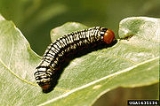
Zebra caterpillar
Encyclopedia
The zebra caterpillar is the larva of an American noctuid
moth (Melanchra picta or Ceramica picta) that feeds on cabbage
s, beet
s and other cultivated plants.
The head, thorax and forewings of adults are chestnut- or reddish-brown, usually with purplish brown mottling on the wings. The whitish hind wings have pale brown margins. The abdomen is light gray. The wingspan is 35 to 40 mm (about 1-1/2 inches).
The newly hatched larvae are whitish, marked by dark heads and several dark spots scattered over the body. The more mature caterpillars vary in color, often displaying bright and conspicuous hues, usually with prominent black and light yellow longitudinal stripes. The top stripe is black, the top-lateral stripe and the stripe below the spiracles are cream to bright yellow, and the spiracle stripe and bottom stripe are black and marked with numerous white lines and spots. The mid-dorsal line is pale and may be well developed or absent. The underside and legs are light red-brown or yellow. The head is reddish or reddish-brown and without dark arcs or reticulations. Larvae are 35 to 40 mm long when mature.
The larvae first feed in small compact groups until molting, after which they scatter throughout the foliage. They feed during the day. When disturbed on foliage, they roll up and fall to the ground.
Zebra caterpillars thrive throughout the United States. Known as general feeders in the western states, they usually become pests in late summer. This caterpillar often exists in a mixed population with the bertha armyworm and the variegated cutworm.
Noctuidae
The Noctuidae or owlet moths are a family of robustly-built moths that includes more than 35,000 known species out of possibly 100,000 total, in more than 4,200 genera. They constitute the largest family in the Lepidoptera....
moth (Melanchra picta or Ceramica picta) that feeds on cabbage
Cabbage
Cabbage is a popular cultivar of the species Brassica oleracea Linne of the Family Brassicaceae and is a leafy green vegetable...
s, beet
Beet
The beet is a plant in the Chenopodiaceae family which is now included in Amaranthaceae family. It is best known in its numerous cultivated varieties, the most well known of which is the purple root vegetable known as the beetroot or garden beet...
s and other cultivated plants.
The head, thorax and forewings of adults are chestnut- or reddish-brown, usually with purplish brown mottling on the wings. The whitish hind wings have pale brown margins. The abdomen is light gray. The wingspan is 35 to 40 mm (about 1-1/2 inches).
The newly hatched larvae are whitish, marked by dark heads and several dark spots scattered over the body. The more mature caterpillars vary in color, often displaying bright and conspicuous hues, usually with prominent black and light yellow longitudinal stripes. The top stripe is black, the top-lateral stripe and the stripe below the spiracles are cream to bright yellow, and the spiracle stripe and bottom stripe are black and marked with numerous white lines and spots. The mid-dorsal line is pale and may be well developed or absent. The underside and legs are light red-brown or yellow. The head is reddish or reddish-brown and without dark arcs or reticulations. Larvae are 35 to 40 mm long when mature.
The larvae first feed in small compact groups until molting, after which they scatter throughout the foliage. They feed during the day. When disturbed on foliage, they roll up and fall to the ground.
Zebra caterpillars thrive throughout the United States. Known as general feeders in the western states, they usually become pests in late summer. This caterpillar often exists in a mixed population with the bertha armyworm and the variegated cutworm.
External links
- Zebra caterpillar. Integrated Pest Management on Peppermint-IPMP3.0, Integrated Plant Protection Center, Oregon State University. Modified from Ralph E. Berry (1998), Insects and Mites of Economic Importance in the Northwest, 2nd ed.
- Recognizing Economically Important Caterpillar Pests of Pacific Northwest Row Crops. A.L. Antonelli, P.J. Landolt, D.F. Mayer, H.W. Homan (2000). Washington State University, Extension Publishing and Printing. Page 13 (text), 15 (pdf file).

